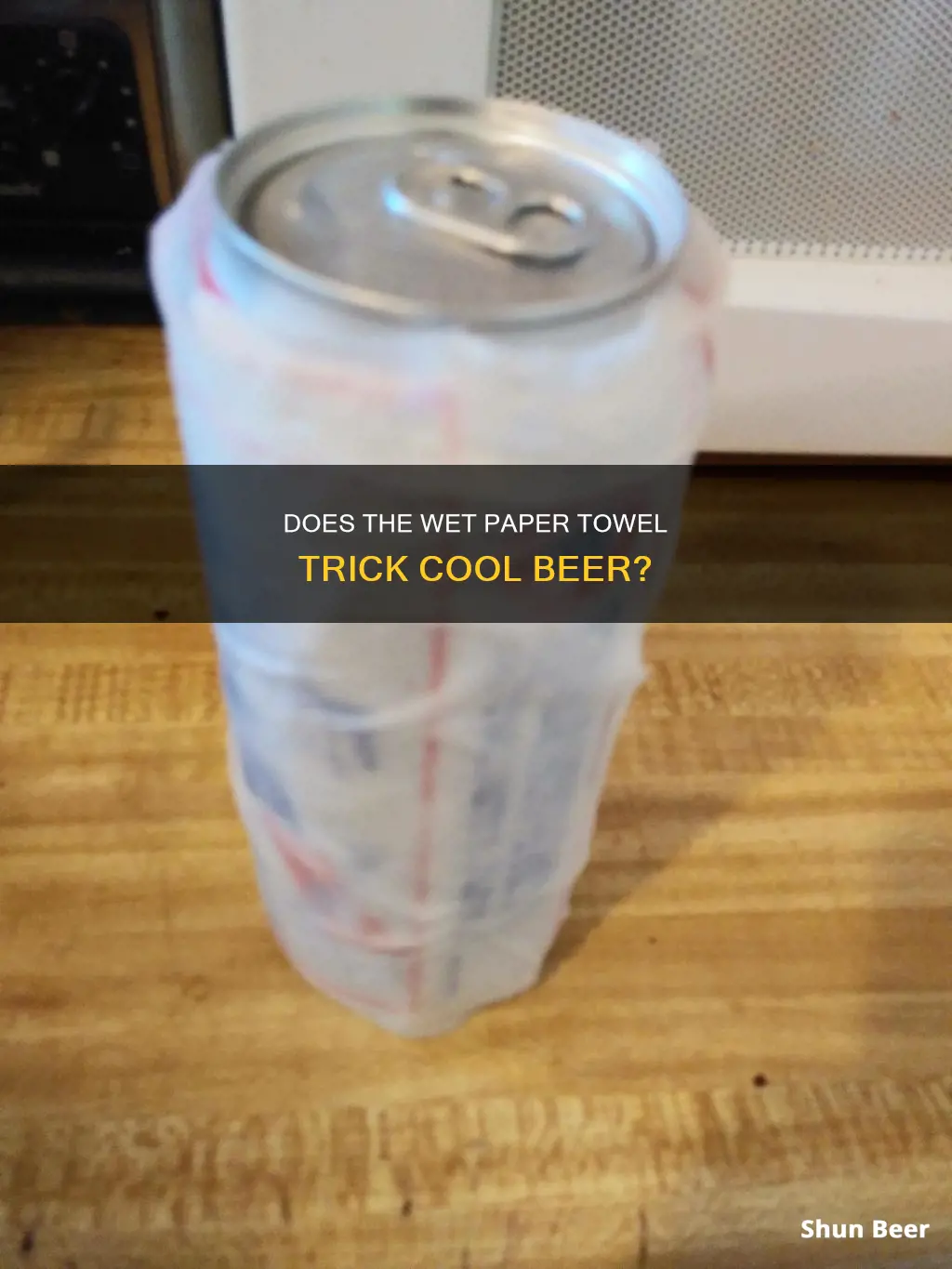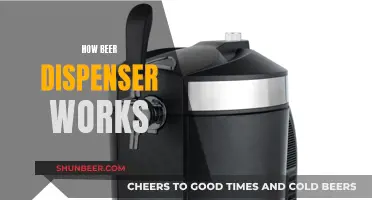
There are many ways to cool beer, and one of the most popular methods is to wrap a wet paper towel around the bottle and place it in the freezer. This method has sparked a lot of debate, with some people claiming that it speeds up the cooling process, while others argue that it slows it down. So, does the wet paper towel trick really work?
| Characteristics | Values |
|---|---|
| Effectiveness | The effectiveness of this method has been debated across the internet. Some experiments have shown that it does work, while others have shown that it does not make a difference or even slows down the cooling process. |
| Factors influencing effectiveness | The effectiveness of this method depends on various factors such as the initial temperature of the beer, the temperature and humidity of the surrounding environment, the type of paper towel used, and the level of advection in the freezer. |
| Mechanism | The proposed mechanism for this method is evaporative cooling. The water from the wet paper towel evaporates, absorbing heat from the beer and the surrounding air, leading to a decrease in temperature. |
| Alternative methods | There are alternative methods for cooling beer quickly, such as adding frozen items, submerging in a salty ice bath, or placing it directly in the freezer. |
What You'll Learn
- The wet paper towel method may be ineffective or even slow down the cooling process
- Evaporation from the wet paper towel may enhance cooling
- The wet paper towel method is more effective in a high-advection environment
- The wet paper towel method may be more effective for water bottles than beer bottles
- The effectiveness of the wet paper towel method may depend on how the towel is wrapped

The wet paper towel method may be ineffective or even slow down the cooling process
The effectiveness of the wet paper towel method has been debated, with some people claiming that it speeds up the cooling process, while others argue that it does the opposite. Several factors come into play when determining the effectiveness of this method, including the initial temperature of the beer, the humidity of the environment, and the type of paper towel used.
One of the main theories behind the wet paper towel method is evaporative cooling. When water evaporates, it absorbs heat from its surroundings, resulting in a decrease in temperature. In the context of cooling beer, the water from the wet paper towel is expected to evaporate, cooling down the beer. However, the presence of air pockets underneath the towel can impede this process, reducing its effectiveness. Additionally, if the humidity in the surrounding environment is high, such as in a refrigerator, the evaporative cooling effect may be minimal.
Another factor to consider is the surface area of the paper towel. If the towel is wrapped smoothly and snugly around the beer, it can increase the surface area available for heat transfer, potentially enhancing the cooling process. However, if the towel is not wrapped properly and creates air pockets, it can act as an insulating layer, slowing down the cooling.
The type of paper towel used can also make a difference. Thicker and more absorbent paper towels can retain more water, potentially improving the cooling effect. However, the water content of the towel is crucial—if the towel is too wet, it may need to release latent heat during freezing, slowing down the cooling process. On the other hand, if the towel is not wet enough, it may not provide sufficient water for effective evaporative cooling.
Overall, while the wet paper towel method may work in certain conditions, such as in a dry and well-ventilated freezer, it is not a reliable method for quickly cooling beer. The presence of air pockets, the initial temperature of the beer, and the humidity of the environment can all influence the effectiveness of this method. In some cases, the wet paper towel may even slow down the cooling process, especially if it is not properly wrapped around the beer. Therefore, it is essential to consider the specific conditions and factors at play before relying on this method to cool your beer.
Understanding Beer Staffs: A Guide to Their Functionality
You may want to see also

Evaporation from the wet paper towel may enhance cooling
The effectiveness of the wet paper towel method depends on several factors. Firstly, the air temperature and humidity levels play a significant role. In a dry environment with low humidity, evaporation occurs more rapidly, leading to a more pronounced cooling effect. Conversely, in humid conditions, evaporation slows down, reducing the cooling impact.
Additionally, the structure and properties of the paper towel influence the outcome. The presence of air pockets within the paper towel can affect heat transfer. The inner surface area of the paper towel becomes crucial when the surface is no longer fully saturated. The size of the paper's pores also comes into play, impacting evaporation rates and, consequently, cooling.
The initial temperature of the beer and the duration of the experiment can also affect the results. Warmer beer may provide a more noticeable cooling effect due to the greater temperature difference. Longer experiment durations may lead to more significant cooling, as evaporation can occur over an extended period.
It is worth noting that some experiments have shown conflicting results, with certain tests indicating that the wet paper towel method slowed down the cooling process. These discrepancies could be attributed to variations in experimental setups, such as the tightness of the paper towel wrapping or the exposure of the bottle neck.
Beer and Bowel Movements: The Laxative Effect
You may want to see also

The wet paper towel method is more effective in a high-advection environment
The wet paper towel method is a popular "hack" for cooling beer quickly. The theory is that wrapping a bottle or can in a wet paper towel and placing it in the freezer will cool the beer faster than placing it in the freezer alone. However, the effectiveness of this method is disputed. Some people claim that it works for them, while others have conducted experiments that suggest it is ineffective or even slows down the cooling process.
One of the key factors that determine the effectiveness of the wet paper towel method is the environment in which it is used. In a high-advection environment, such as a well-ventilated freezer, the wet paper towel method is more likely to be effective. This is because the water from the wet towel can evaporate rapidly in a dry environment, cooling the bottle or can. Additionally, a ventilated freezer facilitates faster heat exchange, further contributing to the cooling effect.
In contrast, in a low-advection environment, such as a refrigerator with high humidity, the wet paper towel method may not work as well. In this case, the evaporation rate of water is slower due to the high humidity, and the extra thermal mass and insulation provided by the wet paper towel may actually slow down the cooling process.
To optimize the wet paper towel method in a high-advection environment, it is important to ensure that the paper towel is thoroughly wet and wrapped snugly around the beer container, with minimal air pockets. This maximizes the surface area of the wet paper towel in contact with the container, facilitating more effective heat transfer. It is also beneficial to use smaller containers, as they have a greater surface-to-volume ratio, which enhances the cooling effect.
Beer Traps: Effective Snail Control or Urban Myth?
You may want to see also

The wet paper towel method may be more effective for water bottles than beer bottles
The wet paper towel method is a popular hack for cooling down warm beverages, such as beer, in a short amount of time. The method involves wrapping a bottle or can in a wet paper towel and placing it in the freezer.
The effectiveness of this method is disputed. Some people claim that it works, while others argue that it is a myth. There have been several attempts to test the theory, with mixed results. One test found that the wet paper towel method resulted in the beverage cooling down more slowly than without the paper towel. This is because the damp paper towel acts as a jacket for the beverage, adding an extra layer for the heat to diffuse through.
However, another test found that the wet paper towel method did work, with the beverage reaching serving temperature an hour faster than without the paper towel. This test used aluminium cans, which may have been a key factor in the success of the method.
Overall, the wet paper towel method may be more effective for water bottles than beer bottles. This is because water bottles are typically made of plastic or glass, which are better conductors of heat than the aluminium cans often used for beer. Additionally, water bottles often have a wider surface area than beer bottles, which would allow the paper towel to come into contact with more of the bottle and potentially increase the cooling effect.
The Magical Math of 79 Beers: Age Subtraction Mystery
You may want to see also

The effectiveness of the wet paper towel method may depend on how the towel is wrapped
The wet paper towel method is a popular "life hack" that claims to cool down a warm beer in minutes. The idea is that you wrap a wet paper towel around a warm beer and put it in the freezer. The water from the towel evaporates, cooling down the beer.
However, the effectiveness of this method has been debated, with some people claiming that it works and others saying it doesn't. Some people suggest that the extra surface area of the paper towel increases the thermal contact with the air, allowing more air to come into contact with the beer and enhancing the cooling effect. Others argue that the wet paper towel acts as an insulator, slowing down the cooling process.
One scientific study found that the wet paper towel method had a negligible impact on cooling time when beers were placed near the freezer fan, which created high levels of advection. However, when beers were placed in a bin to minimize advection or outside the bin with low levels of advection, the wet paper towel reduced the cooling time by approximately 25%.
Another study found that wrapping a glass in a wet paper towel caused it to cool more slowly than an unwrapped glass. However, when the same experiment was conducted with bottles of soda, there was no significant difference in temperature between the wrapped and unwrapped bottles. The authors of the study suggested that this could be due to the fact that the pint glass was totally wrapped vertically, while the bottle had its neck exposed.
Some people have also suggested that the wet paper towel method may work better with certain types of paper towels. Thicker and more absorbent paper towels will have a greater surface area to absorb and retain water, potentially leading to more effective cooling.
Overall, the effectiveness of the wet paper towel method may depend on a variety of factors, including how the towel is wrapped, the type of paper towel used, and the level of advection in the freezer. While some people claim that it works, others argue that it is just a myth. More scientific studies are needed to definitively prove or disprove the effectiveness of this method.
The Magic of Beer Bread: How Does It Work?
You may want to see also
Frequently asked questions
Yes, but only under certain conditions. The effectiveness of this method has been debated, with some claiming that a wet paper towel slows cooling by acting as insulation, while others argue that evaporation from the towel enhances cooling. Experiments have shown that increasing air movement, such as by placing the beer near the freezer fan, reduces cooling time significantly. The wet paper towel method is most effective when combined with high levels of air movement and may reduce cooling time by up to 60%-70%. However, in the absence of significant air movement, the wet paper towel can still reduce cooling time by approximately 25%.
The wet paper towel method aims to accelerate the cooling of beer by enhancing heat removal. The evaporation of water from the wet towel requires energy, which is drawn from the surrounding area, resulting in a decrease in temperature. Additionally, the towel increases the surface area in contact with the cold air, further promoting heat transfer.
The level of air movement or advection plays a crucial role in the cooling process. Placing the beer near the freezer fan creates high levels of advection, which significantly reduces cooling time. The type of paper towel used can also make a difference, with thicker and more absorbent towels providing a larger surface area for evaporation and potentially enhancing the cooling effect.
The wet paper towel method is not as effective as storing beer in a refrigerator or freezer, which provides a colder and controlled environment for cooling. However, it can be a useful technique when quick cooling is needed and other options are not available.
The cooling time can vary depending on factors such as the initial temperature of the beer, the temperature and humidity of the environment, and the type of paper towel used. In general, the method can reduce the cooling time by 25% to 70%, depending on the level of air movement present.







